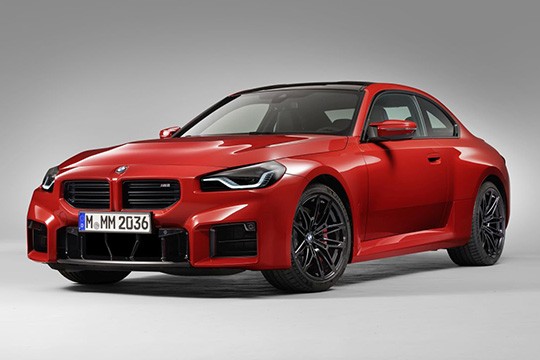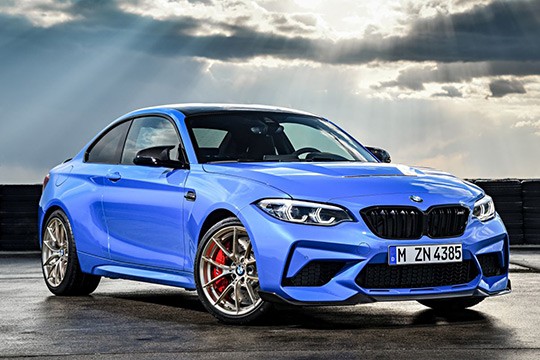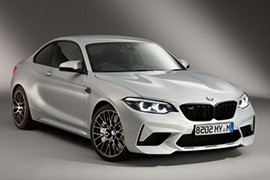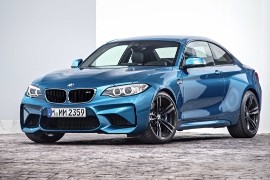BMW M2 Models/Series Timeline, Specifications & Photos
First production year: 2015
Engines: Gasoline
Body style: Coupé (two-door)
BMW introduced the second generation of the M2 nameplate in the fall of 2022, which was more than some expected.
Following its predecessor recipe, the 2022 M2 featured a heart of an M3/M4 stuck in the body of the smaller, nimbler, 2-Series bodywork. Only this time, it was slightly on par in terms of performance with its bigger siblings than its predecessor. Compared with the 2015 M2, it gained 90 more ponies under the hood but was also heavier.
The German carmaker extensively modified the car's exterior compared with its non-M siblings. At the front, the grille was blacked out and more angular. In addition, the front bumper featured squared side scoops and a rectangular center air intake. On the other hand, the flared fenders, both front, and rear, gave the car a muscular appearance. Finally, at the back, the automaker also appealed to the same squared design for the lower bumper and a series of angular cuts and lines, which were unusual for an M-badged Bimmer. Finally, the trunk incorporated a duck-tail that evoked the glorious E46 M3 CSL.
Inside, the dashboard's design was mainly similar to the one offered as an option in the 2-Series Coupe. It sported a pair of screens covered by the same piece of glass and gave the impression of a single unit. Yet, the instrument panel was separated by the touchscreen installed atop the center stack. In addition, the performance-oriented interior was emphasized by the sports bucket seats with integrated headrests and high-bolstered areas.
Under the hood, the automaker relied on the same turbocharged straight-six powerplant available for the M3 and M4. Yet, it didn't provide the same power as its bigger siblings. Moreover, it was not available with an all-wheel-drive system, like its lesser-powered 240i xDrive. But, it was offered with either a six-speed manual or an eight-speed automatic gearbox.
BMW introduced the CS version of the M2 in 2019 more as a track-focused version of the M2, transferring most of the technologies from its larger siblings, the M3 and the M4, including the engine.
While the M2 was praised for its performance and ability to take corners, the M2 CS went to a higher level. Not only did it look meaner, but it was also more powerful and fitted with better underpinnings that transformed the great M2 into a magnificent sports car fit for everyday usage. BMW didn’t want to create a car just for track use but for daily driving situations, and that’s one of the reasons why the M2 CS was incredibly well-received by its fans around the world. Furthermore, it was available with a three-pedal setup, a feat that only a handful of sports car makers kept in their parts bins.
From the outside, the M2 CS featured an aggressive front fascia dominated by the wide kidney grille above the bumper. Still, that cooling area was not enough for the powerplant under the hood, so the automaker added a second one in the apron, below the bumper. That featured a hexagonal shape and was flanked by two additional scoops that cooled the brakes and other radiators. A specific detail for this CS version was the vent on the hood that extracted the hot air from the engine bay. To complete the front visual package, the automaker placed a carbon-fiber lip at the bottom of the apron. From its profile, the M2 CS sported vents on the front fenders and unique side skirts. Finally, at the back, the car had a carbon fiber spoiler on the trunk and a diffuser flanked by four round exhausts underneath the bumper.
Inside, drivers were greeted by a thick, Alcantara-covered three-spoke steering wheel. Surprisingly, it was round, not flat-bottomed, to respect the origins of the M-labeled cars. BMW didn’t stop there and continued with the same materials on the center console, dashboard, and door cards. The sports seats featured high seatbacks with high-bolstered areas and integrated headrests. Just like in the regular M2, there was limited room for two passengers in the back on the bench seat, but those were available and good enough for short jaunts. On the dashboard, BMW installed an analog instrument cluster filled with two large dials for the speedometer and tachometer. Atop the center stack, the automaker placed the screen for the iDrive infotainment system.
Obviously, the most significant part of the M2 CS was under its skin. BMW placed the same S55 inline-six powerplant fed by a pair of turbochargers. Even though it was more track-focused than the M2 Competition, the engine and transmission were still very good on public roads. In addition, the six-speed manual or the seven-speed automatic (dual-clutch) gearboxes were sturdy enough to cope with daily traffic situations.
The M2 was a serious sports car that made many people ask if it wouldn't be a better track-car than the bigger M4. With the introduction of the Competition version, the answer was even difficult.
The German carmaker had a thing with the sport-compact sedans ever since the first BMW M3 was introduced in the '80s. Even though that car was built to get the FIA's race-approval, the carmaker insisted and developed a complete range of M-Power vehicles. The M2 was the smallest, but not the slowest.
The M2 Competition received a new bumper and specific air-intakes to cool the brakes and the engine from the outside. The enlarged BMW kidneys were painted in black, improving the aggressive look of the car. The side vents on the front fenders were black as well. The four exhausts mirrored the same color in the back, differentiating the M2 Competition from the other M Competition models. The M2 Competition was available with an exclusive color: Hockenheim Silver.
The interior was fit for a day at the track with sport-bucket seats at the front. The M2 competition badge was embroiled on the front seats' seatbacks and was present on the door-sills. For the instrument cluster, the designers chose a black background with red needles and white lettering.
The most important elements were on the technical sides. The 3.0-liter, twin-turbo engine offered 410 hp. It was mated to a standard 6-speed manual gearbox while a 7-speed automatic (dual-clutch) was on the options list. An electronically controlled rear differential offered the best traction available.
The BMW 2 Series was a great addition to the German car manufacturer. It was the car that young people desired, in the correct body shape and with a fair price for what it offered. But the top of the range M2 was something even more.
The BMW M2 was launched at the Mazda Laguna Seca Raceway and it was the proper place to show its pace. The differences between the M2 and the other 2-Series were obvious. A different bumper with larger air intakes and flared wheel-arches warned the drivers that under the hood were more hp than the standard 2 Series. A rear spoiler on the trunk lid and a quad-exhaust under the reshaped bumper confirmed that there were more ponies under the hood.
For the track experience, the M2 was fitted with the optional M-DCT gearbox. The brakes were the same as from the M3/M4. The big differences were under the hood where the twin-turbo system from the M3/M4 was replaced with a twin-scroll turbocharger. The result was 61 hp less than the bigger brother, but only a small fraction from 0 to 100 kph (0-62 mph). The M2 didn't have all the good things from its bigger brother, such as the carbon-fiber drive-shaft but so, the price was lower.
The car had an adaptive suspension that made it very comfortable on the road and very nimble. Its wider tracks front and rear, due to a new, aluminum, suspension made it more planted on the road when compared with the regular 2 Series.



